Miele K 2602 Vi, K 2612 Vi, K 2802 Vi, K 2812 Vi, K 2902 Vi Operating instructions
...
Operating and installation
instructions
Refrigerators
To avoid the risk of accidents or damage to the appliance it is essential to read these instructions before it is installed and used for the first time.
en-GB |
M.-Nr. 11 548 190 |

Contents |
|
Warning and Safety instructions...................................................................... |
5 |
Caring for the environment .............................................................................. |
14 |
Installation.......................................................................................................... |
15 |
Location............................................................................................................... |
15 |
Climate range ................................................................................................. |
15 |
Installation notes ................................................................................................. |
16 |
Adjoining cabinets/units................................................................................. |
16 |
Load-bearing capacity of the niche floor ....................................................... |
17 |
Ventilation....................................................................................................... |
17 |
Door hinging................................................................................................... |
17 |
Side-by-side................................................................................................... |
18 |
Building-in dimensions ....................................................................................... |
20 |
Dimensions when the appliance door is opened (opening angle 90°/115°) .. |
22 |
Dimensions of the furniture front......................................................................... |
23 |
Installing the appliance........................................................................................ |
24 |
Before starting ............................................................................................... |
24 |
Tools required................................................................................................. |
24 |
Weight of the furniture front ........................................................................... |
25 |
Aligning the building-in niche ......................................................................... |
25 |
Checking the building-in niche....................................................................... |
26 |
Before installation........................................................................................... |
26 |
Preparing the building-in niche ...................................................................... |
27 |
Pushing the refrigeration appliance into the building-in niche ....................... |
30 |
Aligning the refrigeration appliance................................................................ |
31 |
Securing the refrigeration appliance in the building-in niche ......................... |
34 |
Preparing to install the furniture fronts ........................................................... |
36 |
Securing and aligning the furniture front ........................................................ |
39 |
Securing the covers ....................................................................................... |
43 |
Securing the plinth ventilation grille and plinth panel..................................... |
45 |
Limiting the opening angle of the appliance door.......................................... |
45 |
Electrical connection ........................................................................................... |
46 |
Saving energy .................................................................................................... |
48 |
Guide to the appliance...................................................................................... |
50 |
Main screen......................................................................................................... |
52 |
Settings mode ................................................................................................ |
53 |
Accessories ....................................................................................................... |
55 |
Accessories supplied .......................................................................................... |
55 |
Optional accessories........................................................................................... |
55 |
2

Contents |
|
Initial commissioning ........................................................................................ |
57 |
Before using for the first time .............................................................................. |
57 |
Choosing the right door assistant (Push2open/Pull2open)........................... |
57 |
Inserting the Active AirClean filters ................................................................ |
57 |
Operating the refrigeration appliance.................................................................. |
58 |
Starting up for the first time ........................................................................... |
59 |
Switching on and off ......................................................................................... |
60 |
Switching off for longer periods of time .............................................................. |
60 |
Selecting additional settings............................................................................ |
61 |
Switching Keypad lock / on or off ............................................................... |
61 |
Adjusting the temperature in the MasterFresh zone (dry compartment) ....... |
62 |
Switching Eco mode on or off........................................................................ |
62 |
Performing a Self test ..................................................................................... |
63 |
Switching on the Door assistant ...................................................................... |
64 |
Switching off the Door assistant ..................................................................... |
66 |
Setting up Miele@home ...................................................................................... |
66 |
Switching off the Demo mode .......................................................................... |
70 |
Resetting the settings to their default settings .............................................. |
71 |
Switching Sabbath mode on or off.................................................................. |
73 |
Switching on, switching off or resetting the Display Active AirClean filter ..... |
74 |
The correct temperature................................................................................... |
76 |
... in the refrigerator section and in the MasterFresh zone .................................. |
76 |
Automatic temperature distribution (DynaCool) ............................................. |
76 |
Setting the temperature....................................................................................... |
77 |
Adjusting the temperature in the dry compartment of the MasterFresh zone |
77 |
Temperature range ......................................................................................... |
77 |
Using Super cool ............................................................................................... |
78 |
Door alarm ......................................................................................................... |
79 |
Adjusting the interior fittings............................................................................ |
80 |
Removing or moving the door shelves................................................................ |
80 |
Removing or moving the shelves ........................................................................ |
80 |
Removing the hanging drawer ............................................................................ |
81 |
Removing compartments from the refrigerator section ...................................... |
82 |
Storing food in the refrigerator section........................................................... |
83 |
Different storage zones ....................................................................................... |
83 |
Food which is not suitable for storage in the refrigerator section ....................... |
84 |
Notes on buying food.......................................................................................... |
85 |
Storing food correctly.......................................................................................... |
85 |
3

Contents |
|
Storing food in the MasterFresh zone ............................................................. |
86 |
MasterFresh zone ................................................................................................ |
86 |
Humidity-controlled compartment with moisture adjustment........................ |
86 |
Dry compartment with adjustable temperature.............................................. |
88 |
Automatic defrosting ........................................................................................ |
90 |
Cleaning and care ............................................................................................. |
91 |
Cleaning agents................................................................................................... |
91 |
Before cleaning the refrigeration appliance......................................................... |
92 |
Interior cabinet and accessories ......................................................................... |
92 |
Cleaning the door seal ........................................................................................ |
93 |
Cleaning the ventilation gaps .............................................................................. |
93 |
Replacing the Active AirClean filters ................................................................... |
93 |
After cleaning ...................................................................................................... |
94 |
Problem solving guide ...................................................................................... |
95 |
Noises................................................................................................................. |
100 |
Service................................................................................................................ |
101 |
Contact in the event of a fault ............................................................................. |
101 |
EPREL database ................................................................................................. |
101 |
Warranty .............................................................................................................. |
101 |
Conformity declaration ..................................................................................... |
102 |
Copyrights and Licences.................................................................................. |
103 |
4

Warning and Safety instructions
This refrigeration appliance complies with current safety requirements. Inappropriate use can, however, lead to personal injury and material damage.
Please read the operating and installation instructions carefully before using the refrigeration appliance for the first time. They contain important information on safety, installation, use and maintenance. This is to protect yourself from injury, and from damaging your refrigeration appliance.
In accordance with standard IEC 60335-1, Miele expressly and strongly advises that you read and follow the instructions in the chapter on installing the appliance as well as the safety instructions and warnings.
Miele cannot be held liable for injury or damage caused by noncompliance with these instructions.
Keep these instructions in a safe place and pass them on to any future owner.
Risk of injury and damage due to the refrigeration appliance tipping over.
This refrigeration appliance is very heavy and can tip forwards when the appliance door is open.
Keep the appliance door shut until the refrigeration appliance has been built in and secured in its installation niche in accordance with the operating and installation instructions.
5

Warning and Safety instructions
Correct application
This refrigeration appliance is intended for use in the home and in similar environments, for example
– in shops, offices and similar work settings
– by the guests in hotels, motels, bed & breakfasts and other typical home settings.
This refrigeration appliance is not intended for outdoor use.
This appliance is intended for domestic use only for cooling and storing food and drink.
It must not be used for any other purpose.
This refrigeration appliance is not suitable for storing and keeping cool medicines, blood plasma, laboratory preparations or similar substances or products that are subject to the the Medical Device Directive. Incorrect use of the refrigeration appliance for such purposes may cause deterioration of the items stored. The refrigeration appliance is also not suitable for use in areas where there is a risk of explosion.
Miele cannot be held liable for damage caused by improper or incorrect use or operation of the appliance.
The appliance can only be used by people with reduced physical, sensory or mental capabilities, or lack of experience and knowledge, if they are supervised whilst using it, or have been shown how to use it in a safe way and recognise and understand the consequences of incorrect operation.
6

Warning and Safety instructions
Safety with children
Children under 8 years of age must be kept away from the refrigeration appliance unless they are constantly supervised.
Children 8 years and older may only use the appliance unsupervised if they have been shown how to use it in a safe way and recognise and understand the consequences of incorrect operation.
Children must not be allowed to clean or maintain the appliance unsupervised.
Please supervise children in the vicinity of the appliance and do not let them play with it.
The appliance door hinges can cause injury. Keep children away at all times.
Danger of suffocation! Whilst playing, children could become entangled in packaging (such as plastic wrapping) or pull it over their head and suffocate. Keep packaging material away from children.
7
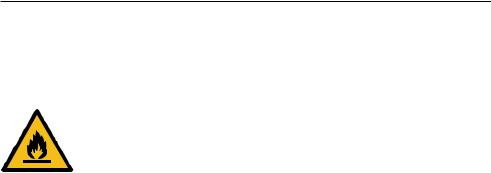
Warning and Safety instructions
Technical safety
The coolant circuit has been checked for leaks. The refrigeration appliance complies with statutory safety requirements and the appropriate EU directives.
This refrigeration appliance contains the refrigerant isobutane (R600a), a natural gas which is environmentally friendly but flammable. The refrigerant does not damage the ozone layer and does not contribute to the greenhouse effect.
The use of this refrigerant has, however, led to a slight increase in the noise level of the appliance. In addition to the noise of the compressor, you might be able to hear the refrigerant flowing around the cooling circuit. Unfortunately, this cannot be avoided, but it does not affect the performance of the refrigeration appliance.
When transporting and installing the refrigeration appliance, ensure that no parts of the cooling circuit are damaged. Splashes of refrigerant can damage the eyes.
In the event of damage:
-Avoid naked flames or anything which creates a spark.
-Disconnect the refrigeration appliance from the mains electricity supply.
-Ventilate the room where the refrigeration appliance is located for several minutes.
-Contact the Miele Customer Service Department.
The more coolant there is in a refrigeration appliance, the larger the room it should be installed in. In the event of a leakage, if the appliance is in a small room, there is the danger of a combustible gas/ air mixture building up. For every 11 g of coolant at least 1 m3 of room space is required. The amount of coolant in the refrigeration appliance is stated on the data plate inside the appliance.
8

Warning and Safety instructions
To avoid the risk of damage to the appliance, make sure that the connection data (fuse rating, frequency and voltage) on the data plate corresponds to the household supply.
Check that this is the case before connecting the appliance. Consult a qualified electrician if in any doubt.
The electrical safety of this appliance can only be guaranteed when correctly earthed. It is essential that this standard safety requirement is met. If in any doubt please have the electrical installation tested by a qualified electrician.
Reliable and safe operation of this appliance can only be assured if it has been connected to the mains electricity supply.
The socket must not be concealed behind the refrigeration appliance and must be easily accessible so that the appliance can be quickly disconnected from the electrical supply in case of an emergency.
If the electrical connection cable supplied is damaged, it must only be replaced by an original spare part to prevent a hazard for the user. Miele can only guarantee the safety of the appliance when original Miele spare parts are used.
Do not connect the appliance to the mains electrical supply by a multi-socket adapter or extension lead. These are a fire hazard and do not guarantee the required safety of the appliance.
If moisture gets into electrical components or into the mains connection cable, it could cause a short circuit. Therefore, do not operate this refrigeration appliance in areas which are exposed to moisture (e.g in a garage or utility room).
This appliance must not be used in a non-stationary location (e.g. on a ship).
Do not use a damaged appliance. It could be dangerous. Check the appliance for visible signs of damage.
9

Warning and Safety instructions
For safety reasons, this appliance may only be used after it has been built in.
The appliance must be isolated from the electricity supply during installation, maintenance and repair work.
Unauthorised installation, maintenance and repairs can cause considerable danger for the user.
Installation, maintenance and repairs must only be carried out by a Miele authorised technician.
While the appliance is under warranty, repairs should only be undertaken by a Miele authorised service technician. Otherwise the warranty is invalidated.
Miele can only guarantee the safety of the appliance when genuine original Miele replacement parts are used. Faulty components must only be replaced by Miele spare parts.
This refrigeration appliance is supplied with a special lamp to cope with particular conditions (e.g. temperature, moisture, chemical resistance, abrasion resistance and vibration). This lamp must only be used for the purpose for which it is intended. The lamp is not suitable for room lighting. Replacement lamps may only be fitted by a Miele authorised technician or by the Miele Customer Service Department. This refrigeration appliance contains light sources rated as energy efficiency class F.
Correct use
The appliance is designed for use within a certain climate range (ambient temperatures), and should not be used outside this range. The climate range for your appliance is stated on the data plate inside the appliance. Installing it in a room with too low an ambient temperature, e.g. a garage, will lead to the appliance switching off for longer periods so that it cannot maintain the required temperature.
10

Warning and Safety instructions
Do not cover or block the air vents as this could impair the efficiency of the appliance, increase the electricity consumption and could cause damage to the components.
If storing food which contains a lot of fat or oil in the appliance or the door, make sure that it does not come into contact with plastic components as this could cause stress cracks or break the plastic.
Risk of fire and explosion. Do not store explosive materials in the refrigeration appliance or any products containing propellants (e.g. spray cans). Electrical components can cause flammable mixes of gases to ignite.
Danger of explosion. Do not operate any electrical equipment (e.g. an electric ice-cream maker) inside the refrigeration appliance. Danger of sparking and explosion.
Observe the manufacturer's “use-by” dates and storage instructions given on food to avoid the risk of food poisoning. Storage times will depend on several factors, including the freshness and quality of the food, as well as the temperature at which it is stored.
11

Warning and Safety instructions
Accessories and spare parts
Only use genuine original Miele accessories and spare parts with this appliance. Using accessories or spare parts from other manufacturers will invalidate the warranty, and Miele cannot accept liability.
Miele will guarantee to supply functional spare parts for 15 years following the discontinuation of your refrigeration appliance. Functional spare parts are available from the Miele Customer Service Department.
Cleaning and care
Do not use any oils or grease on the door seals, as these will cause the seals to deteriorate and become porous with time.
Do not use a steam cleaning appliance to clean or defrost this appliance.
Steam could reach electrical components and cause a short circuit.
Sharp edged or pointed objects will damage the evaporator, causing irreversible damage to the appliance. Do not use sharp edged or pointed objects to
-remove frost and ice,
-separate frozen food or remove ice trays.
Do not place electric heaters or candles in the appliance to defrost it. These can damage the plastic parts.
Do not use defrosting sprays or de-icers, as they could contain substances which could damage the plastic parts or which might cause the build-up of gases and pose a danger to health.
12

Warning and Safety instructions
Transport
Always transport the appliance in an upright position and in its original transport packaging to avoid damage in transit.
Danger of injury and damage to the appliance. The refrigeration appliance is very heavy and must be transported by two people.
Disposal of your old appliance
If your old refrigeration appliance has a door lock, destroy it. This will prevent the risk of children playing accidentally locking themselves in and endangering their lives.
Splashes of coolant can damage the eyes. Be careful not to damage any part of the pipework whilst awaiting disposal, e.g. by
-puncturing the coolant channels in the condenser,
-bending any pipework, or
-scratching the surface coating.
13
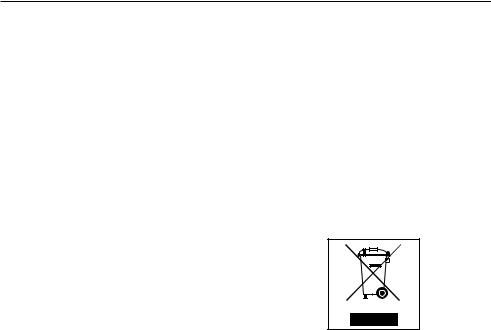
Caring for the environment
Disposal of the packing mater-
ial
The packaging is designed to protect the appliance from damage during transportation. The packaging materials used are selected from materials which are environmentally friendly for disposal and should be recycled.
Recycling the packaging reduces the use of raw materials in the manufacturing process and also reduces the amount of waste in landfill sites.
Disposing of your old appli-
ance
Electronic and electrical appliances contain many valuable materials. They also contain certain materials, compounds and components which were essential for their correct functioning and safety. These could be hazardous to your health and to the environment if disposed of with general waste or if handled incorrectly. Please do not, therefore, dispose of your old appliance with general waste.
Instead, please make use of officially designated collection and disposal points to dispose of and recycle electrical and electronic appliances in your local community, with your dealer or with Miele. By law, you are solely responsible for deleting any personal data from the appliance prior to disposal.
Take care not to damage your refrigeration appliance’s pipework before or during transportation to an authorised collection depot.
This is to ensure that coolant in the cooling circuit and oil in the compressor is contained, and will not leak into the environment.
Please ensure that your old appliance poses no risk to children while being stored prior to disposal. For further information, see “Warning and Safety instructions” in these operating and installation instructions.
14

Installation
Location
This appliance should be installed in a dry, well-ventilated room.
When deciding where to install your refrigeration appliance, please bear in mind that it will use more energy if installed near to a heater, a cooker or other appliance that gives off heat. Direct sunlight should also be avoided. The higher the room temperature, the longer the compressor runs and the higher the energy consumption of the refrigeration appliance is.
When installing the refrigeration appliance, please note the following:
-The socket must be easily accessible in an emergency, not concealed behind the appliance.
-The plug and power cable must not touch the rear of the refrigeration appliance as they could be damaged by vibrations from the appliance.
-Do not plug in other appliances behind the refrigeration appliance.
If installation near a heat source is unavoidable, observe the following minimum distances between the appliance and the heat source:
-At least 3 cm
to electric or gas stoves
-At least 30 cm
to oil or coal-based stoves
If it is not possible to observe these minimum distances, an isolation plate must be installed between the refrigeration appliance and the heat source.
Climate range
The appliance is designed for use within a certain climate range (ambient temperatures) and should not be used outside this range. The climate range of the appliance is stated on the data plate inside the appliance.
Climate range |
Ambient room |
|
temperature |
|
|
SN |
+10 to +32 °C |
|
|
N |
+16 to +32 °C |
|
|
ST |
+16 to +38 °C |
|
|
T |
+16 to +43 °C |
|
|
Operating in a room which is too cold will cause the compressor to switch off for too long, causing the internal temperature in the appliance to rise with the risk of food deteriorating and going off.
15

Installation
Risk of damage due to high humidity.
In environments with high humidity, condensation can build up on external refrigeration appliance panels, which can cause corrosion.
Install the refrigeration appliance in a dry and/or air-conditioned room with sufficient ventilation.
After installation, make sure that the appliance door closes properly, the ventilation gaps are not covered and that the refrigeration appliance has been installed in accordance with these operating and installation instructions.
Installation notes
Risk of damage and injury due to the refrigeration appliance tipping over.
This refrigeration appliance is very heavy and can tip forwards when the appliance door(s) is (are) open. Keep the appliance door(s) shut until the refrigeration appliance has been built in and secured in its housing in
accordance with these operating and installation instructions.
Due to its weight and size, the refrigeration appliance must be installed by two people.
Adjoining cabinets/units
The appliance is screwed to the adjoining cabinets/units to the side and above. For this reason, it is essential that all cabinets/units are fixed to the ground or wall.
16

Installation
Load-bearing capacity of the niche floor
To ensure the safe installation of the refrigeration appliance and to guarantee its correct functioning, the floor of the niche where the appliance is to be installed must be smooth and even.
It must be made from strong, rigid material.
Because the refrigeration appliance is extremely heavy when fully loaded, it is essential that the floor it stands on is able to bear its weight. If necessary, seek the advice of an architect or construction expert.
When fully loaded, the weight of the refrigeration appliance is approx.:
K 2602 Vi, K 2612 Vi |
325 kg |
K 2802 Vi, K 2812 Vi |
380 kg |
K 2902 Vi, K 2912 Vi |
448 kg |
Ventilation
Risk of fire and damage due to insufficient ventilation.
If the refrigeration appliance is not ventilated sufficiently, the compressor will run more frequently and for longer periods.
This will result in increased energy consumption and a higher operating temperature for the compressor. This may, in turn, cause damage to the compressor.
Please ensure that there is adequate ventilation around the refrigeration appliance.
It is essential to observe the required ventilation gaps. The ventilation gaps must not be covered or blocked in any way.
Door hinging
Risk of damage and injury when changing the door hinges. Changing the door hinges singlehandedly can cause damage to the appliance and injury.
The refrigeration appliance is supplied with fixed hinges. Under no circumstances should you attempt to change the door hinges yourself.
If you need to change the door hinges to the other side, please contact the Miele Customer Service Department.
17
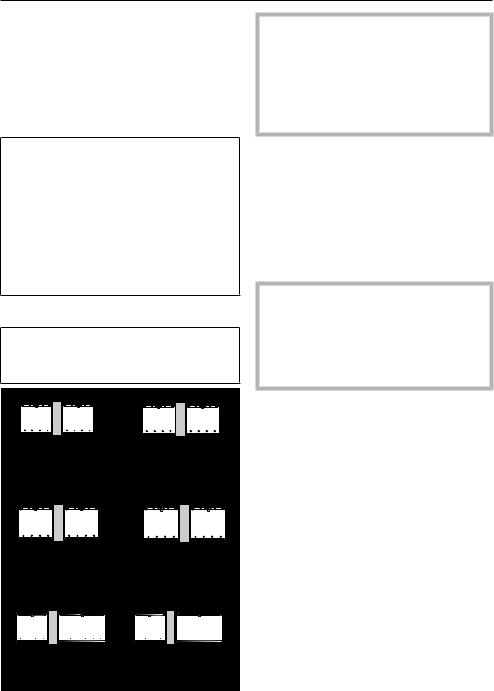
Installation
Side-by-side
This appliance can be installed side-by- side with another refrigeration appliance. The following overview will show you which side-by-side installation options you have with your refrigeration appliance.
Depending on the installation situation, you will need the side-by-side installation kit for side-by-side installation (see “Accessories – Optional accessories”).
Instructions for installing refrigeration appliances side-by-side can be found in the side-by-side installation kit installation instructions.
. . . with partition wall
The wall a between the side-by-side refrigeration appliances must be at least 16 mm thick.
If the door hinges of the refrigeration appliances are next to each other, you must take into account the thickness of the furniture fronts and door handles so that the appliance doors do not collide and become damaged if they are opened at the same time.
The refrigeration appliances are secured individually in their installation niche using the supplied installation material.
If the partition wall a is narrower than 160 mm, you will need the side panel heater from the side-by-side installation kit to prevent condensation from forming and any resulting damage.
When planning installation niches, please note that the niche into which the refrigeration appliance with the side panel heater is installed must be
4 mm wider (see “Installation – Building-in dimensions”).
If the partition wall a is thicker than 160 mm, you do not need the side-by- side installation kit, nor the side panel heater.
18

Installation
. . . without partition wall
If the refrigeration appliances are to be installed next to each other without a partition wall between them, they will need to be joined together with the side-by-side installation kit. In addition, you must install the side panel heater to prevent condensation from forming and any resulting damage.
19
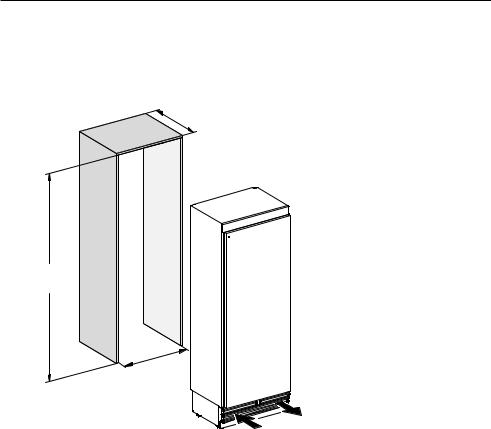
Installation
Building-in dimensions
C
A
B
|
|
A |
B |
C |
|
|
|
|
|
K 2602 Vi, |
2134–2164 mm |
610 mm |
610 mm + furniture front |
|
K 2612 Vi |
|
|
(19–38 mm) |
|
|
|
|
|
|
K 2802 |
Vi, |
2134–2164 mm |
762 mm |
610 mm + furniture front |
K 2812 |
Vi |
|
|
(19–38 mm) |
|
|
|
|
|
K 2902 |
Vi, |
2134–2164 mm |
915 mm |
610 mm + furniture front |
K 2912 |
Vi |
|
|
(19–38 mm) |
|
|
|
|
|
20

Installation
|
|
|
|
|
|
|
|
|
|
|
|
|
|
|
|
|
|
|
|
|
|
30 mm |
|
|
|
|
|
|
|||||||
≥ 262 mm |
|
|
22 mm |
||||||||
|
|
|
|
|
|
|
|
|
|
|
|
≥ 85 mm
102 mm |
≥ 102 mm |
Side view
21
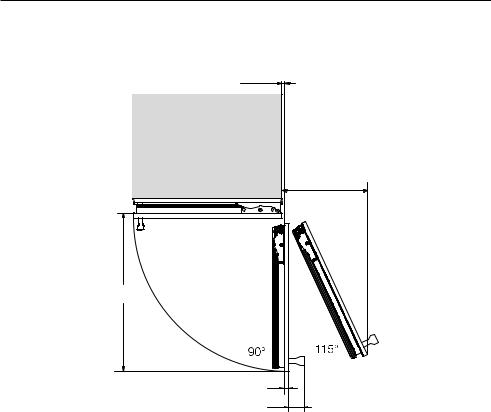
Installation
Dimensions when the appliance door is opened (opening angle 90°/115°)
10 mm
D |
A |
B |
C |
|
|
A |
B* |
C* |
D (with a furniture |
|
|
|
|
|
front of 19 mm) |
|
|
|
|
|
|
K 2602 Vi, |
677 mm |
Furniture |
Door handle |
296 mm |
|
K 2612 Vi |
|
front |
|
|
|
|
|
|
(19–38 mm) |
|
|
|
|
|
|
|
|
K 2802 |
Vi, |
829 mm |
Furniture |
Door handle |
363 mm |
K 2812 |
Vi |
|
front |
|
|
|
|
|
(19–38 mm) |
|
|
|
|
|
|
|
|
K 2902 |
Vi, |
982 mm |
Furniture |
Door handle |
428 mm |
K 2912 |
Vi |
|
front |
|
|
|
|
|
(19–38 mm) |
|
|
|
|
|
|
|
|
* The dimensions of the furniture front and the door handle vary depending on the
design of the kitchen.
22

Installation
Dimensions of the furniture front
A |
B |
C |
|
A |
B |
C |
K 2602 Vi, |
604 mm |
2029 mm |
≥ 102–132 mm |
K 2612 Vi |
|
|
≥ 102–132 mm |
K 2802 Vi, |
756 mm |
2029 mm |
|
K 2812 Vi |
|
|
≥ 102–132 mm |
K 2902 Vi, |
908 mm |
2029 mm |
|
K 2912 Vi |
|
|
|
|
|
|
|
23

Installation
Installing the appliance
Before starting ...
It is essential to read these operating and installation instructions carefully before starting to install the refrigeration appliance.
The refrigeration appliance should be installed by a suitably qualified installer in accordance with these operating and installation instructions. Safe operation of the refrigeration appliance is only assured if it has been installed and connected in accordance with these operating and installation instructions.
Risk of damage and injury due to the refrigeration appliance tipping over.
This refrigeration appliance is very heavy and can tip forwards when the appliance door is open.
Keep the appliance door shut until the refrigeration appliance has been built in and secured in its niche in accordance with these operating and installation instructions.
Due to its weight and size, the refrigeration appliance must be installed by two people.
Tools required
-Cordless drill
-TX 20 screwdriver
-Hammer drill
-Drill bits in various sizes, depending on materials
-Hammer
-Open spanner
-Ratchet wrench, attachment: socket, 8 mm
-Adhesive tape
-Utility knife
-Pipe wrench
-Spirit level
-Tape measure
-Pencil
Other
-Step ladder
-Sack truck
24

Installation
Weight of the furniture front |
Aligning the building-in niche |
Before fitting a furniture front, ensure that the weight of the furniture front does not exceed the maximum permitted weight:
Refrigeration appli- |
Max. weight |
ance |
of the fur- |
|
niture front |
|
|
K 2602 Vi, K 2612 Vi |
48 kg |
|
|
K 2802 Vi, K 2812 Vi |
27 kg |
|
|
K 2902 Vi, K 2912 Vi |
48 kg |
|
|
If the furniture front is too heavy, this can cause damage.
Fitting a furniture front which is heavier than the maximum permitted weight could damage the hinges. This damage can affect various factors, such as operation of the appliance.
Before fitting a furniture front, ensure that the weight of the furniture front does not exceed the maximum permitted weight.
The building-in niche must be carefully aligned using a spirit level before the refrigeration appliance is installed. The niche corners must be at 90° angles to each other, otherwise the furniture front will not sit straight on all 4 corners of the building-in niche.
25

Installation
Checking the building-in niche
Check the installation dimensions (see “Installation – Building-in dimensions”).
Check the position of the electrical connection. The length of the electrical connection cable is 3 m.
The electrical socket must not be concealed behind the appliance and must be easily accessible in an emergency.
Check the surroundings for possible collisions (see “Installation – Dimensions with appliance door open”).
Only install the refrigeration appliance in stable, solid building-in niches, positioned on an even and level floor.
Also check the building-in niche for the following criteria:
-The side walls of the building-in niche must be even.
-The surrounding walls of the buildingin niche must be at least 16 mm thick.
-The surrounding walls must be securely fixed to the floor or wall.
-Shortened side walls must be at least 100 mm deep.
Before installation
Before installation, remove any accessories from the back of the appliance.
Check the refrigeration appliance for transport damage.
Do not install a damaged refrigeration appliance.
Check that all parts at the back of the appliance are unhindered.
To protect the floor during installation, secure an off-cut of flooring or similar material to the floor in front of the installation area.
26

Installation
Do not remove the installation aids from the appliance door. These will be required later for aligning the appliance in the building-in niche.
Risk of damage and injury due to the refrigeration appliance tipping over.
As soon as you unscrew the brackets that fix the refrigeration appliance to the pallet, the appliance is no longer secured.
Due to its weight and size, the refrigeration appliance must be installed by two people.
Unscrew the fixing brackets .
With the help of several people as required, carefully lift the refrigeration appliance from the pallet, starting with the back of the appliance.
Risk of damaging the floor from the load.
Moving the refrigeration appliance can cause damage to the floor. Move the refrigeration appliance carefully on floors that are sensitive to scratching.
As soon as you have set the refrigeration appliance upright, you can move it using the rollers on the bottom.
Preparing the building-in niche
Risk of damage and injury due to the refrigeration appliance tipping over.
This refrigeration appliance is very heavy and can tip forwards when the appliance doors are open.
The building-in niche must be secured to the wall behind it and/or above it with several screws. Only this will prevent the refrigeration appliance from tipping over after being installed.
In addition, use the provided anti-tip brackets to secure the building-in niche.
The parts required for installation are supplied with the refrigeration appliance. The plastic bags supplied are marked with letters for easy identification.
27
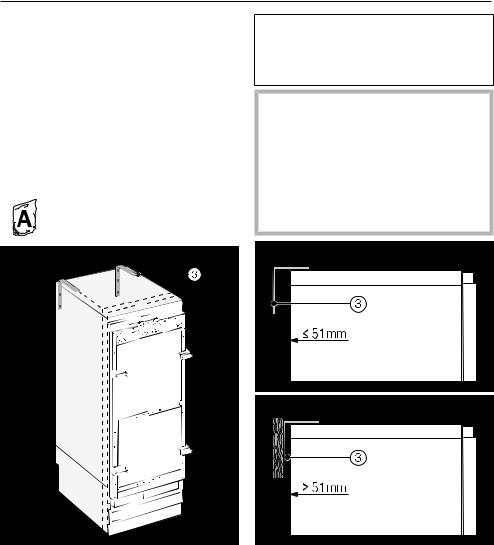
Installation
When performing the individual assembly steps, observe the letters specified and use the matching plastic bag with the required installation equipment.
The anti-tip brackets prevent the refrigeration appliance from tipping.
The anti-tip brackets are also used to fix the building-in niche securely to the surrounding walls.
Use 2 anti-tip brackets for each individual refrigeration appliance or 4 anti-tip brackets for each (side-by- side) combination of 2 appliances.
Position the anti-tip brackets on the left and right of the building-in niche.
Depending on the subsequent adjustment of the feet, the anti-tip brackets are positioned 2134–2164 mm from the floor of the niche.
Risk of injury and damage due to tipping refrigeration appliance.
If the anti-tip brackets are fixed too high up, they cannot be used to secure the refrigeration appliance.
The distance between the
anti-tip brackets and the refrigeration appliance must not exceed 8 mm.
Make sure that the gap between the refrigeration appliance‘s rear wall and the building-in niche does not exceed 51 mm.
Place a wooden wedge behind the anti-tip brackets if necessary.
28

Installation
While holding the anti-tip brackets in place, mark the necessary drill holes on the rear wall of the building-in niche.
The accessory pack supplied contains fixing screws for various applications/materials.
Securing with a wooden wedge
Secure the building-in niche to the
wall behind it and/or above it as re-
quired using the anti-tip brackets .
Securing to a concrete wall
Securing to a wooden wall
29

Installation
Pushing the refrigeration appliance into the building-in niche
Take care not to damage the electrical connection whilst pushing the refrigeration appliance into the build- ing-in niche.
If you are installing several refrigeration appliances side by side, now secure the appliances to one another (see the installation instructions for the side-by-side installation kit).
To ensure that the refrigeration appliance can then be aligned correctly, the plinth ventilation grille must be removed from the appliance plinth:
Carefully guide a flat-head screwdriver through the plinth ventilation grille on both sides and use it to push the internal plastic latches outwards to release the plinth ventilation grille.
Place the plinth ventilation grille to one side.
Affix edge protection to the adjacent furniture fronts.
Insert the plug connector at the back of the refrigeration appliance (see “Installation – Electrical connection”).
Insert the plug into the socket.
The electrical socket must not be concealed behind the appliance and must be easily accessible in an emergency.
Risk of damage due to electrical overload.
If the refrigeration appliance is electrically overloaded, this can cause a short circuit and thus damage your refrigeration appliance.
When you install appliances side by side, each refrigeration appliance must have its own separate electrical socket.
Tip: Secure the power cable to prevent it becoming caught: tie a piece of string to the middle of the cable and as the refrigeration appliance is being pushed into the niche, pull the cable forward underneath the appliance.
30
